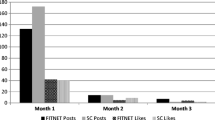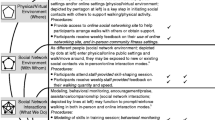Abstract
Despite their widespread use and extensive technical features, little is known about how to use online social networking sites to increase physical activity. This study aims to examine Facebook engagement among participants in the online social networking arm of a randomized controlled physical activity promotion trial (n = 67). Facebook communications were double coded and analyzed using ATLAS.ti. Regression procedures were used to determine predictors of Facebook use and associations between types of use and changes in perceived social support and physical activity. Changes in perceived social support and physical activity were more strongly associated with participants’ individual Facebook use than use of the Facebook intervention group. The way social media sites are used in intervention design could have an impact on their effects. Including existing friends in interventions and using applications that incorporate intervention activities into a more naturalistic use of Facebook may improve the efficacy of future interventions.
Similar content being viewed by others
References
Buis LR. The potential for web-based social network sites and self-regulation for health promotion. Am J Health Promot. 2011; 26(2): 73-76.
Bennett GG, Glasgow RE. The delivery of public health interventions via the internet: actualizing their potential. Annu Rev Public Health. 2009; 30: 273-292.
Duggan M, Brenner J. The demographics of social media users—2012. Washington, DC: Pew Research Center; 2013.
Boyd DM, Ellison NB. Social network sites: definition, history, and scholarship. J Comput Mediat Commun. 2007; 13(1): 210-230.
Chou WY, Hunt YM, Beckjord EB, Moser RP, Hesse BW. Social media use in the United States: implications for health communication. J Med Internet Res. 2009; 11(4): e48.
Napolitano MA, Hayes S, Bennett GG, Ives A, Foster GD. Using Facebook and text messaging to deliver a weight loss program to college students. Obesity (Silver Spring). 2013; 21: 25-31.
Cavallo DN, Tate DF, Ries AV, Brown JD, Devellis RF, Ammerman AS. A social media-based physical activity intervention: a randomized controlled trial. Am J Prev Med. 2012; 43(5): 527-532.
Turner-McGrievy G, Tate D. Tweets, apps, and pods: results of the 6-month mobile pounds off digitally (mobile POD) randomized weight-loss intervention among adults. J Med Internet Res. 2011; 13(4): e120.
Cunningham SA, Vaquera E, Maturo CC, Narayan KM. Is there evidence that friends influence body weight? A systematic review of empirical research. Soc Sci Med. 2012; 75(7): 1175-1183.
Greaves CJ, Sheppard KE, Abraham C, et al. Systematic review of reviews of intervention components associated with increased effectiveness in dietary and physical activity interventions. BMC Public Health. 2011; 11: 119.
Kelsey K, Earp JL, Kirkley BG. Is social support beneficial for dietary change? A review of the literature. Fam Community Health. 1997; 20(3): 70-82.
Van Der Horst K, Paw MJ, Twisk JW, Van Mechelen W. A brief review on correlates of physical activity and sedentariness in youth. Med Sci Sports Exerc. 2007; 39(8): 1241-1250.
Hwang KO, Etchegaray JM, Sciamanna CN, Bernstam EV, Thomas EJ. Structural social support predicts functional social support in an online weight loss programme. Health Expect. 2012; 17(3): 345-352.
Hwang KO, Ottenbacher AJ, Green AP, et al. Social support in an internet weight loss community. Int J Med Inform. 2010; 79(1): 5-13.
McKay HG, King D, Eakin EG, Seeley JR, Glasgow RE. The diabetes network Internet-based physical activity intervention—a randomized pilot study. Diabetes Care. 2001; 24(8): 1328-1334.
Poirier J, Cobb NK. Social influence as a driver of engagement in a web-based health intervention. J Med Internet Res. 2012; 14(1): e36.
Tate DF, Wing RR, Winett RA. Using internet technology to deliver a behavioral weight loss program. JAMA. 2001; 285(9): 1172-1177.
Turner-McGrievy G, Tate D. Weight loss social support in 140 characters or less: use of an online social network in a remotely delivered weight loss intervention. Transl Behav Med. 2013; e.1-8.
Foster D, Linehan, C., Kirman, B., Lawson, S., & James, G. Motivating physical activity at work: using persuasive social media for competitive step counting. Paper presented at: Proceedings of the 14th International Academic MindTrek Conference on Envisioning Future Media Environments MindTrek 10 (2010)2010; Tampere Finland.
Kim C, Draska M, Hess ML, Wilson EJ, Richardson CR. A web-based pedometer programme in women with a recent history of gestational diabetes. Diabet Med. 2012; 29(2): 278-283.
Kosma M, Cardinal BJ, McCubbin JA. A pilot study of a web-based physical activity motivational program for adults with physical disabilities. Disabil Rehabil. 2005; 27(23): 1435-1442.
Cobb NK, Graham AL. Health behavior interventions in the age of Facebook. Am J Prev Med. 2012; 43(5): 571-572.
Perry L, Morgan J, Reid F, et al. Screening for symptoms of eating disorders: reliability of the SCOFF screening tool with written compared to oral delivery. Int J Eat Disord. 2002; 32(4): 466-472.
Thomas S, Reading J, Shephard RJ. Revision of the physical activity readiness questionnaire (PAR-Q). Can J Sport Sci. 1992; 17(4): 338-345.
Chogahara M. A multidimensional scale for assessing positive and negative social influences on physical activity in older adults. J Gerontol B Psychol Sci Soc Sci. 1999; 54(6): S356-S367.
Okun MA, Ruehlman L, Karoly P, Lutz R, Fairholme C, Schaub R. Social support and social norms: do both contribute to predicting leisure-time exercise? Am J Health Behav. 2003; 27(5): 493-507.
Pereira MA, FitzerGerald SJ, Gregg EW, et al. A collection of Physical Activity Questionnaires for health-related research. Med Sci Sports Exerc. 1997; 29(6 Suppl): S1-S205.
Ellison NB, Steinfield C, Lampe C. The benefits of Facebook “friends”: Social capital and college students’ use of online social network sites. J Comput Mediat Commun. 2007; 12(4): 1143-1168.
Strauss A, Corbin J. Basics of qualitative research: grounded theory procedures and techniques. Newbury Park: Sage Publications; 1990.
Miles M, Huberman A. Qualitative data analysis. 2nd ed. Thousand Oaks (CA): Sage; 1994.
Berkman LF, Glass T, Brissette I, Seeman TE. From social integration to health: Durkheim in the new millennium. Soc Sci Med. 2000; 51(6): 843-857.
Bond RM, Fariss CJ, Jones JJ, et al. A 61-million-person experiment in social influence and political mobilization. Nature. 2012; 489(7415): 295-298.
Bull SS, Levine DK, Black SR, Schmiege SJ, Santelli J. Social media-delivered sexual health intervention: a cluster randomized controlled trial. Am J Prev Med. 2012; 43(5): 467-474.
Nonnecke B, Preece J. Lurker demographics: counting the silent. 2000.
Kontos EZ, Emmons KM, Puleo E, Viswanath K. Communication inequalities and public health implications of adult social networking site use in the United States. J Health Commun. 2010; 15(S3): 216-235.
Acknowledgments
This research was supported by the Lineberger Comprehensive Cancer Center Cancer Control Education Program, Predoctoral Fellowship, UNC (5R25-CA057726) and by a grant from NIH (DK056350) to the University of North Carolina Nutrition Obesity Research Center.
Conflict of interest
All authors of this manuscript declare that they have no conflicts to report.
Ethical standards and informed consent
All procedures followed were in accordance with the ethical standards of the responsible committee on human experimentation (institutional and national) and with the Helsinki Declaration of 1975, as revised in 2000. Informed consent was obtained from all participants for being included in the study.
Author information
Authors and Affiliations
Corresponding author
Additional information
Implications
Practice: Establishing groups within online social networks to promote social support for physical activity may be less effective than instructing participants to enlist their existing connections.
Policy: Although social networking sites may provide an easily disseminated means of delivering physical activity interventions, large-scale programs should be delayed until more is known about the principles underlying their use.
Research: Research is needed to establish underlying principles of effectiveness in the use of social networking sites to promote physical activity.
About this article
Cite this article
Cavallo, D.N., Tate, D.F., Ward, D.S. et al. Social support for physical activity—role of Facebook with and without structured intervention. Behav. Med. Pract. Policy Res. 4, 346–354 (2014). https://doi.org/10.1007/s13142-014-0269-9
Published:
Issue Date:
DOI: https://doi.org/10.1007/s13142-014-0269-9




